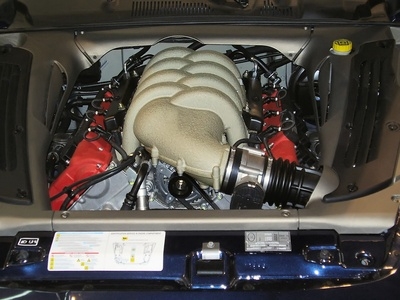
Squealing sounds in a Taurus are caused by moving parts rubbing together. Metal in contact with either metal, rubber or ceramic can make squeals. These parts are either rubbing or spinning. Examples include bearings, struts, belts and brakes. A squeal may indicate serious problems, but many are maintenance issues or minor annoyances. Certain driving conditions may also create temporary squeals. You can pinpoint the source of most squeals with a little persistence and an understanding of contact points.
Shine a flashlight through the front wheel slots. The brake rotor is a polished metal disc behind the wheel. Run your finger over the rotor. Deep grooves or a warped feeling indicate you need a brake job. Intermittent squealing or a high squeak when applying brakes is common. Check with your mechanic about anti-squeak brake pads. Consistent brake grinding or pedal vibration is not normal.
Get your shocks and struts inspected if you notice excessive squeaking or squealing when going over bumps. They could be worn, or bolts may be loose. Have the strut towers checked.
Check your wiper blades if they squeal when the windshield is wet. A retainer clip may be loose. If the wiper is touching the glass, fix it immediately. It's like fingers on a chalkboard, and it will damage the windshield. A squealing wiper on a dry windshield does not indicate a problem.
Open the hood, and check the power-steering-fluid reservoir, located just behind the radiator on the passenger's side of the engine. If it's very low, the bearing may be squealing. Fill the unit to the proper level.
Examine the drive belt. Check for oil or water leaks, which may spill onto the belt and cause it to slip. Use a flashlight to inspect the back side of the belt for wear. Look for deep cracks in the ribbed areas. The Taurus Owner's Manual recommends replacing the drive belt every 30,000 miles.
Wear work gloves, and find the drive belt tensioner, which is a pulley about 3 inches in diameter attached to a spring-loaded lever. The drive belt runs over the pulley. Grasp the pulley, and try to wiggle it. Push on the belt to check the tightness. It should not move more than an inch. Replace the tensioner if it is loose, has excessive play or if metal shavings are seen nearby.
Start the engine and leave the A/C off. Shine a flashlight on the tensioner pulley and watch it. Replace the pulley if it constantly moves back and forth, wobbles or squeals. Listen closely since noisy belts are more common than a malfunctioning tensioner.
Turn on the air conditioning and listen for any changes. An early sign of compressor failure is a sudden squeal when it is engaged. It can also be a sign of a weak tensioner.
Leave the engine running, turn the fan on low and then gradually increase the blower speed. Persistent squealing is a sign that the blower motor bearings may be failing and need to be replaced. However, moisture or dust can get into the unit, making it squeal intermittently without a mechanical failure.
Turn the steering wheel completely to the left. Wait 5 seconds, then turn it completely to the right. A screeching or squealing sound is normal here. The power steering relief valve is bleeding off excess pressure. Squealing while turning points to a drive belt issue that needs to be looked at by a mechanic.
Listen for noises coming from the Taurus steering column while turning the wheel. It means the bushings are dry or worn. This is not a major concern, although it can be irritating.
Roll the windows down and back up. Treat the rubber seals with vinyl protectant if they're squealing. Lubricate noisy door hinges with oil or a spray lubricant.